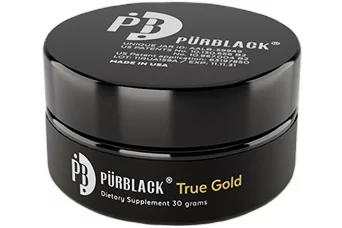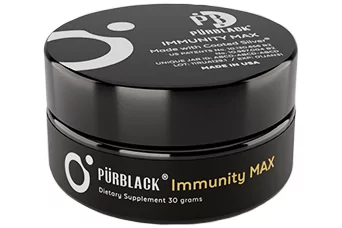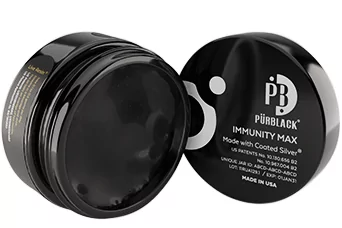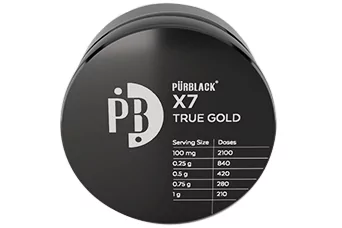BBB customer reviews
POTENTE. PURO. NATURAL.

¿Qué es Shilajit?
La materia biológica orgánica tarda décadas en triturarse y quedar atrapada entre las rocas de las zonas más elevadas de la Tierra. En estas condiciones atmosféricas específicas, las plantas medicinales fermentadas se convierten en la materia prima, maravilla de la naturaleza, conocida como shilajit.
Estas rocas se recogen de forma natural en las grietas de las montañas, se purifican y se transforman artesanalmente en resina de shilajit siguiendo las normas más estrictas.
Como una fuente de nutrientes, elementos naturales y sustancias orgánicas biológicamente activas, Pürblack está diseñado para ser el más exclusivo super nutriente antiguo diseñado para la salud y la longevidad.
AFINA EL CUERPO
Pürblack Live Resin® afina tu cuerpo hasta su máximo potencial. Los beneficios de Pürblack superan los de cualquier shilajit convencional.
OPTIMIZA LA SANGRE Y LAS HORMONAS
- Optimiza una respuesta saludable a la inflamación.
- Refuerza el sistema inmunitario.
- Produce un potente efecto antienvejecimiento.
- Suministra rápidamente minerales raros, metabolitos y antioxidantes a todas las células
CEREBRO Y EMOCIONES SALUDABLES
- Mejora la cognición y favorece la concentración.
- Aumenta la capacidad para resistir los factores estresantes mentales, emocionales y sociales.
- Optimiza el equilibrio cerebral para una sensación de conexión a tierra y productividad.
- Provoca un estado mental más tranquilo mientras se trabaja o estudia.
HUESOS, MÚSCULOS Y ÓRGANOS FUERTES.
- Rápida regeneración de los tejidos sanos del cuerpo.
- Huesos, músculos y tendones más fuertes.
- Desintoxicación acelerada del tejido de los órganos.
- Mejora el enriquecimiento de oxígeno y nutrientes en todo el cuerpo.
POTENCIADOR NATURAL DEL RENDIMIENTO
- Potenciador del rendimiento físico y mental.
- Aumenta la libido y el rendimiento en hombres y mujeres.
- Efectos adaptógenos naturales sin agotamiento.
- Mejora la regeneración celular y la producción de energía.
CONTROL EFICAZ DEL PESO
- Favorece unos niveles saludables de azúcar e insulina en sangre.
- Suprime el aumento o el exceso de apetito.
- Proporciona la energía necesaria para un estilo de vida activo.
- Ayuda a construir músculo para aumentar la quema de grasa.
MEJORA DEL SUEÑO
- Optimiza los ciclos de sueño y el estado de alerta durante la vigilia.
- Adapta rápidamente su cuerpo a su ubicación geomagnética, mejorando así la calidad del sueño.
- Ayuda al organismo durante la falta de sueño.
- Disminuye rápidamente el jetlag.
Designed for those who pave their own path forward.
CONCEBIDO PARA QUIENES ABREN SU PROPIO CAMINO.
Pürblack es el principal suplemento de micronutrientes del planeta. Siendo el shilajit más potente, limpio y saludable del mercado actual, ampliamos la conversación añadiendo oro porque nuestro objetivo principal es educar, potenciar y mejorar la vida de nuestros clientes.
- Contenido de oro de más de 555PPM.
- Apoya el desarrollo de alto coeficiente intelectual.
- Alto contenido de oro apoya el bienestar de las articulaciones.
- Contenido de oro de más de 555PPM.
- Apoya el desarrollo de alto coeficiente intelectual.
- Alto contenido de oro apoya el bienestar de las articulaciones.
LOS MÁS VENDIDOS
Sale


Shilajit Live Resin 30 grams with Pürscale Device
1.55$ per daily dosage (avg 2 mth)
30 g
$93.33
Sale


Shilajit Immunity Max 30 grams with Pürscale Device
1.66$ per daily dosage (avg 2 mth)
30 g
$99.99
Sale


Shilajit Resin X7 True Gold 210 grams with 2 Pürscale Devices
1.19$ per daily dosage (avg 14 mth)
210 g
$500.00
4
EL MAYOR CONTENIDO DE ORO DEL MUNDO.
El oro elemental contiene numerosos beneficios para las personas a muchos niveles. Con 555PPM, nuestro contenido en oro es el más alto del mercado.
5
LA MEJOR SEGURIDAD Y AUTENTICIDAD DE SU CLASE.
Cada lote se somete a pruebas de seguridad y pureza en laboratorios estadounidenses independientes y cuenta con un certificado de análisis.
6
NUNCA UN POLVO, PÍLDORA, TABLETA O TINTURA
Shilajit es puro y genuino y contiene su máxima eficacia en forma de resina. Nunca produciremos píldoras, gotas, polvos o tabletas.
¿POR QUÉ ELEGIR PÜRBLACK?
Diseñado para ser excepcional
1
TECNOLOGÍA PATENTADA. FABRICADO EN EE.UU.
Nos dedicamos a producir shilajit de calidad diseñado para nutrir la mente y el cuerpo a un nivel microscópico.
2
MAYOR EFICACIA Y MÁS BENEFICIOS QUE CUALQUIER OTRO SHILAJIT.
Pürblack es una resina de 5ª generación que nunca contendrá metales pesados, impurezas u otros peligros potenciales para la salud que otros shilajit contienen.
3
BENEFICIOS EXCLUSIVOS DE LA RESINA PÜRBLACK.
Como el activo distintivo de un estilo de vida consciente de la salud, los beneficios de shilajit Pürblack están exquisitamente adaptados para el cuerpo y la mente.



